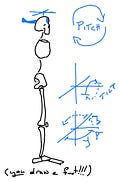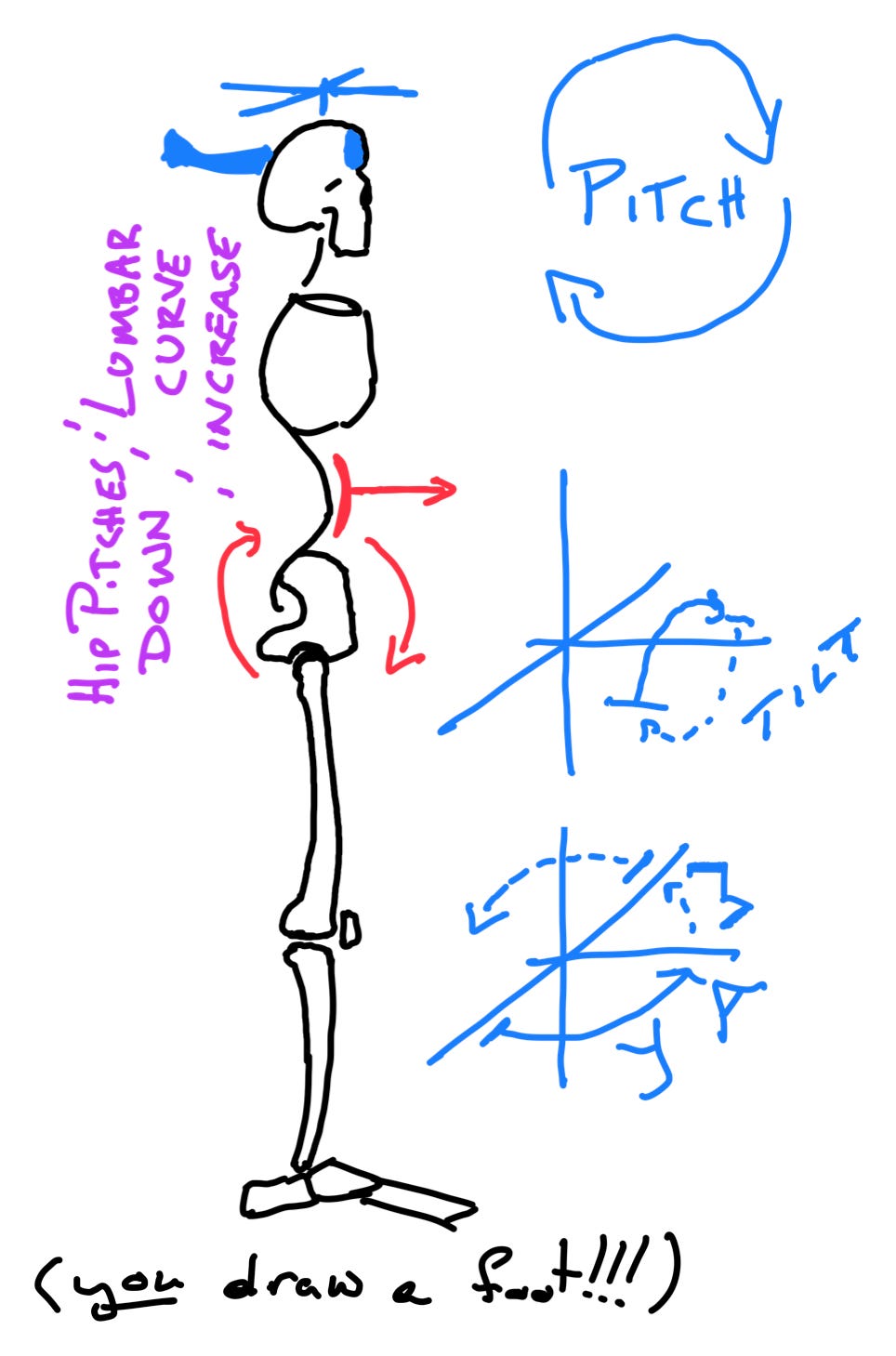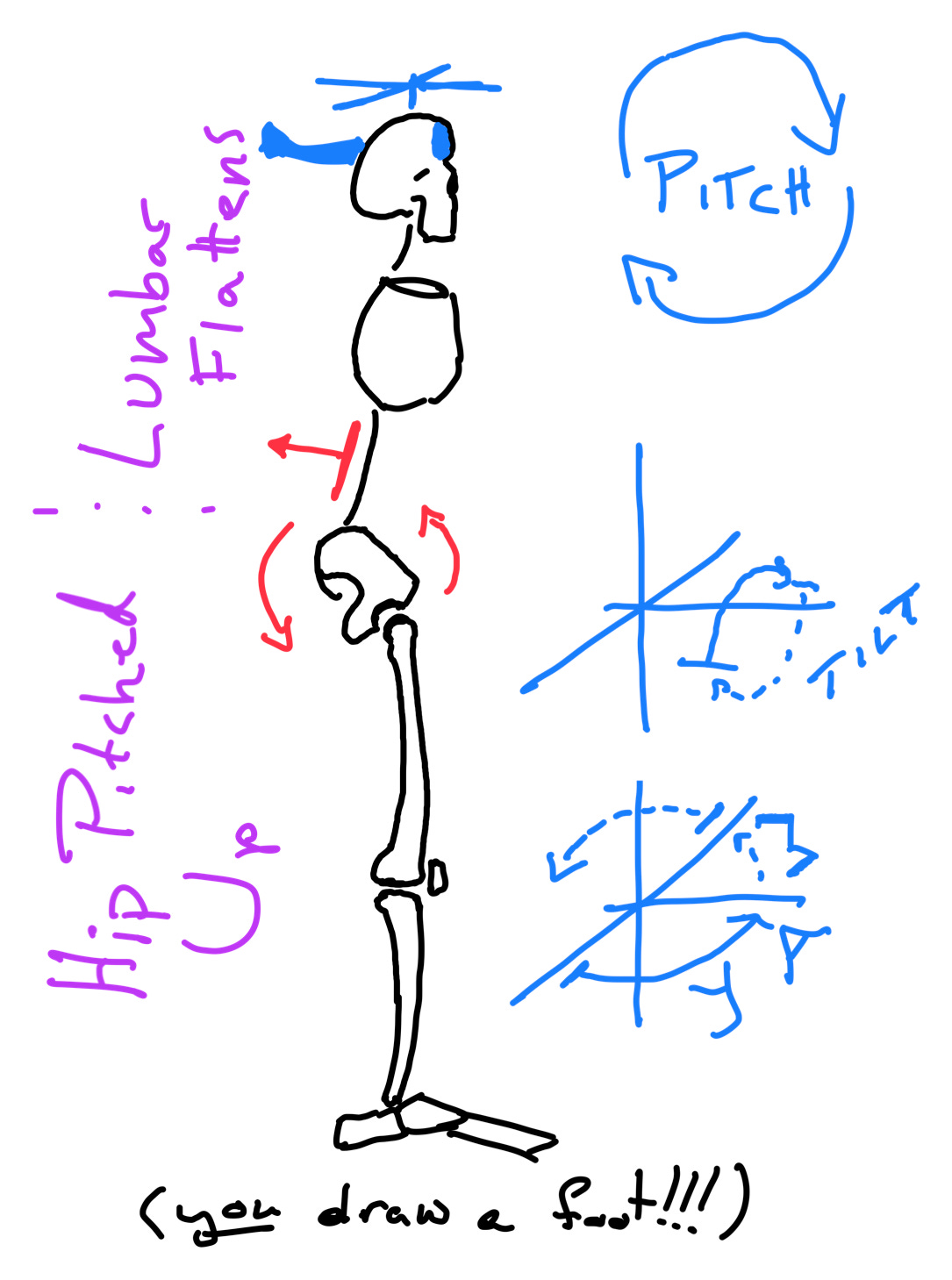Welcome to another post in my Know Your Habit series. If you’d like to stay in the loop and get the whole series, please take a second to subscribe! It’s free!
Know Your Habit
The purpose of this series is to give you a better idea of who you are and what you are doing. If you would like more context on what I’m covering, please check out The Rubrics of the Alexander Technique. You’ll find links for Part 1 and Part 2 there as well!
Happy Hips!
Before I walk through some examples of unhappy hips, let’s take a look at the drawing below.
I’ve drawn a person standing up… without arms… and have drawn a little helicopter on the head. The three axes - pitch, tilt, and yaw - are drawn in blue to the right hand side of the person. In the anatomical world, you would hear the phrase anterior/posterior pelvic tilt or left/right lateral tilt used to describe various hip movements. Personally, I will not do this because I prefer to use pitch, tilt, and yaw for the head, chest, and pelvis.
Basically, I think of the ribs and hips suspending below the head and by hook or by crook these objects can get twisted off centre. I want one simple system of directions to write down and I hope this isn’t too confusing for anyone!
When the Hip Pitches Down
Above, I’ve drawn the hips pitching down. Is this caused by the head pressing down into the spine? Probably. Is this felt as a weakness in the lower back or knee? Also probably!
One thing I can say for certain is that if the hip is pitching down you will have a ton of pressure built up along the front of the hips and you will have an arch in the back.
It may be possible to have the hip not pitched down and have a severe arch in the back. If this happened I would guess there was a rather severe accident involved.1
When the Hip Pitches Up
The picture above is a rather odd one because the hip is normally going to find this position while sitting with a rounded back/slump in the lower back. I’ve drawn this example in standing because you can absolutely do this… especially if you bend your knees. Notice that if you begin to pitch up in the hips like this you will very likely flatten the lumbar curve of the spine.
I would imagine that this creates quite the feeling of heaviness in the torso. A disproportionate amount of weight would be in the furthest forward portion of the spinal column. In sitting, you would want a lumbar support (cushion) on your desk chair.
Tucking the Pelvis
After my first few weeks of Alexander Technique lessons, I decided to check out Qi Gong (Tai Chi). I went to a very good school in Times Square and the instructor gave directions while I did my best to follow along. More than once, the instructor asked us to tuck the pelvis (pitch up in the hip) while we were standing with our knees bent.
I had no idea what to do with this instruction.
If I had to wager a guess, I would say that the vast majority of folks have a tendency to arch the back and pitch down in the hip. As an instructor in a group setting, it is difficult to give a universal set of directions to help everyone organise themselves. The result is that the instructor’s directions are quite applicable to some but not all members of the class.
If you know your habits you will have a better chance of knowing if these general instructions apply to you or not!
Hopefully these drawings make sense! The arch in the back and the pitch in the hips are extremely tied together for most folks. In time, I hope you’ll feel the entire pattern of the curves of the spine as one thing rather than all of these different chunks but I think it helps to break things down!
Get In Touch
Thanks for reading “Know Your Habit: Part 3“! If you’re in NYC, you may learn more about my private teaching practice at johndalto.com.
If you’d like to book any lesson time with me, you can find my booking link here.
Please understand that as I walk through these examples I will not go through every combination. BUT using math we can at least count how many combinations there are!
Each axis - pitch, tilt, and yaw - has 3 options [{‘-’}, {‘0’}, {‘+’}]. This means that there are 27 possible ways to direct the head off centre. By extension, the rib cage and the hips each have 27 possible ways to direct off centre. This gives us 19,683 ways to direct the head, ribs, and hips. I will not be drawing all of these!





